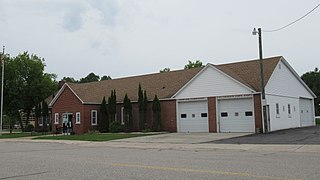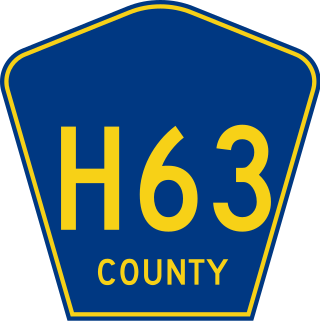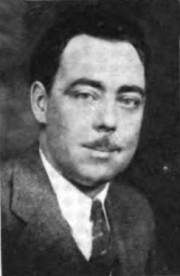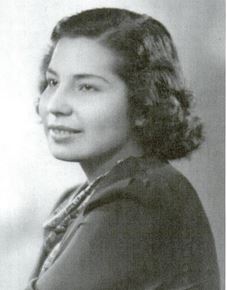
The Upper Peninsulaof Michigan—also known as Upper Michigan or colloquially the U.P. or Yoop—is the northern and more elevated of the two major landmasses that make up the U.S. state of Michigan; it is separated from the Lower Peninsula by the Straits of Mackinac. It is bounded primarily by Lake Superior to the north, separated from the Canadian province of Ontario at the east end by the St. Marys River, and flanked by Lake Huron and Lake Michigan along much of its south. Although the peninsula extends as a geographic feature into the state of Wisconsin, the state boundary follows the Montreal and Menominee rivers and a line connecting them.

Mackinac County is a county in the Upper Peninsula of the U.S. state of Michigan. As of the 2020 census, the population was 10,834. The county seat is St. Ignace. Formerly known as Michilimackinac County, in 1818 it was one of the first counties of the Michigan Territory, as it had long been a center of French and British colonial fur trading, a Catholic church and Protestant mission, and associated settlement.

Chippewa County is a county in the eastern Upper Peninsula of the U.S. state of Michigan. As of the 2020 census, the population was 36,785. The county seat is Sault Ste. Marie. The county is named for the Ojibwe (Chippewa) people, and was set off and organized in 1826. Chippewa County comprises the Sault Ste. Marie, MI micropolitan statistical area.

Sault Ste. Marie is a city in the Upper Peninsula of the U.S. state of Michigan. It is the county seat of Chippewa County and is the only city within the county. With a population of 13,337 at the 2020 census, it is the second-most populated city in the Upper Peninsula, behind Marquette. It is the primary city of the Sault Ste. Marie, MI Micropolitan Statistical Area, which encompasses all of Chippewa County and had a population of 36,785 at the 2020 census. Sault Ste. Marie was settled by mostly French colonists in 1668, making it the oldest city in Michigan.

Newton Township is a civil township of Mackinac County in the U.S. state of Michigan. As of 2020, its population was 430.

St. Ignace is a city in the U.S. state of Michigan and the county seat of Mackinac County. The city had a population of 2,306 at the 2020 census. St. Ignace Township is located just to the north of the city; the two are administered separately.

Mackinaw City is a village at the northernmost point of the Lower Peninsula of Michigan, United States. Divided between Cheboygan and Emmet counties, Mackinaw City is located at the southern end of the Mackinac Bridge, which carries Interstate 75 over the Straits of Mackinac to St. Ignace, in the Upper Peninsula. Mackinaw City and St. Ignace also serve as access points for ferries to and from Mackinac Island. For these reasons, Mackinaw City is considered one of Michigan's most popular tourist attractions.

Moral Re-Armament (MRA) was an international moral and spiritual movement that, in 1938, developed from American minister Frank Buchman's Oxford Group. Buchman headed MRA for 23 years until his death in 1961. In 2001, the movement was renamed Initiatives of Change.

H-63 is a county-designated highway (CDH) in the Upper Peninsula of the US state of Michigan. The highway parallels the Interstate 75 (I-75) corridor between St. Ignace and Sault Ste. Marie. The road is called Mackinac Trail after the Upper Peninsula branch of an Indian trail used before European settlers reached the area. Originally, the roadway was built as a section of US Highway 2 (US 2) before being added to the CDH system in the 1970s.

The Sault Ste. Marie Tribe of Chippewa Indians, commonly shortened to Sault Tribe of Chippewa Indians or the more colloquial Soo Tribe, is a federally recognized Native American tribe in what is now known as Michigan's Upper Peninsula. The tribal headquarters is located within Sault Ste. Marie, the major city in the region, which is located on the St. Marys River.

Area code 906 is the telephone area code in the North American Numbering Plan (NANP) for the Upper Peninsula of Michigan.

Chief Wawatam was a coal-fired steel ship that was based, for most of its working life, in St. Ignace, Michigan. The vessel was named after a distinguished Ojibwa chief of the 1760s. In initial revenue service, the Chief Wawatam served as a train ferry, passenger ferry and icebreaker that operated year-round at the Straits of Mackinac between St. Ignace and Mackinaw City, Michigan. During the winter months, it sometimes took many hours to cross the five-mile-wide Straits, and Chief Wawatam was fitted with complete passenger hospitality spaces.

Interstate 75 (I-75) is a part of the Interstate Highway System that runs north–south from Miami, Florida, to Sault Ste. Marie in the Upper Peninsula of the US state of Michigan. I-75 enters the state from Ohio in the south, north of Toledo, and runs generally northward through Detroit, Flint, and Bay City, crosses the Mackinac Bridge, and ends at the Canadian border in Sault Ste. Marie. The freeway runs for approximately 396 miles (637 km) on both of Michigan's major peninsulas. The landscapes traversed by I-75 include Southern Michigan farmland, northern forests, suburban bedroom communities, and the urban core of Detroit. The freeway also uses three of the state's monumental bridges to cross major bodies of water. There are four auxiliary Interstates in the state related to I-75, as well as nine current or former business routes, with either Business Loop I-75 or Business Spur I-75 designations.

US Highway 2 (US 2) is a component of the United States Numbered Highway System that connects Everett, Washington, to the Upper Peninsula (UP) of the US state of Michigan, with a separate segment that runs from Rouses Point, New York, to Houlton, Maine. In Michigan, the highway runs through the UP in two segments as a part of the state trunkline highway system, entering the state at Ironwood and ending at St. Ignace; in between, US 2 briefly traverses the state of Wisconsin. As one of the major transportation arteries in the UP, US 2 is a major conduit for traffic through the state and neighboring northern Midwest states. Two sections of the roadway are included as part of the Great Lakes Circle Tours, and other segments are listed as state-designated Pure Michigan Byways. There are several memorial highway designations and historic bridges along US 2 that date to the 1910s and 1920s. The highway runs through rural sections of the UP, passing through two national and two state forests in the process.

Wilfird Francis Doyle was a politician in the state of Michigan.

Mission Point is located on the southeast side of Mackinac Island, Michigan. It is approximately 21 acres (8.5 ha) in size between Robinson's Folly and the jetty terminating near Franks Street. The Island has a history of documented European development beginning with French Jesuit missionaries landing at the point in 1634, less than two decades after the Pilgrims landed at Plymouth Rock on the East Coast of North America.

Wawatam Lighthouse is an automated, modern lighthouse that guards the harbor of St. Ignace, Michigan, in the Straits of Mackinac. Originally completely nonfunctional, it was erected in 1998 by the Michigan Department of Transportation (MDOT) near Monroe, Michigan as an iconic roadside attraction at a welcome center that greeted northbound drivers on Interstate 75 (I-75). After serving in this capacity for six years, the structure was threatened in 2004 when MDOT decided to rebuild the welcome center and demolish the tower.

Waunetta McClellan Dominic was an Odawa rights activist who spent her career advocating for the United States government to adhere to its treaty obligations to Native Americans. She was one of the founders of the Northern Michigan Ottawa Association and her influence was widely recognized, especially after winning a 1971 claim against the government for compensation under 19th-century treaties. She was also a proponent of Native American fishing rights being protected. In 1979, she was named by The Detroit News as "Michiganian of the Year" and in 1996, she was posthumously inducted into the Michigan Women's Hall of Fame.




















